By Leen Randell
Updated: Jul 04, 2024
10 Best Herbal Decoctions For Lower Back Pain
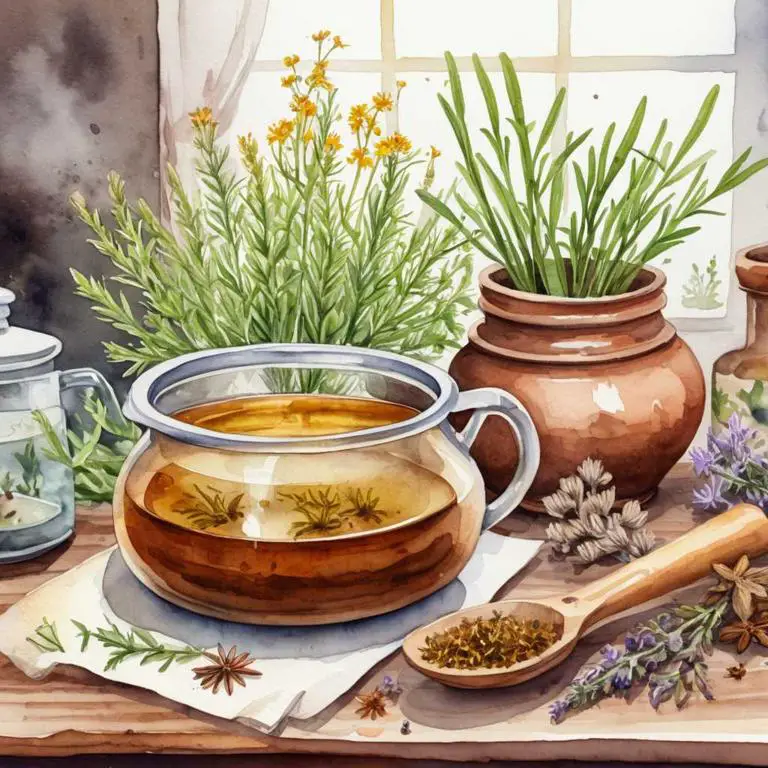
Herbal decoctions for lower back pain are a natural remedy made by steeping herbs in hot water to create a concentrated liquid extract.
These decoctions help alleviate lower back pain by reducing inflammation, relaxing muscles, and improving joint mobility. Examples of herbal decoctions that provide relief include ginger, turmeric, and willow bark, which have anti-inflammatory properties.
Regular consumption of these decoctions can improve daily life for individuals suffering from chronic lower back pain, allowing them to engage in activities they previously found painful or difficult, such as hiking or playing with grandchildren.
The following article describes in detail the most important decoctions for lower back pain, including medicinal properties, parts of herbs to use, and recipes for preparations.
- 1. Corydalis yanhusuo
- 2. Curcuma longa
- 3. Withania somnifera
- 4. Boswellia serrata
- 5. Zingiber officinale
- 6. Salix alba
- 7. Valeriana officinalis
- 8. Harpagophytum procumbens
- 9. Capsicum annuum
- 10. Carthamus tinctorius
- What is the best combination of herbal decoctions to use for lower back pain?
- What ailments similar to lower back pain are treated with herbal decoctions?
1. Corydalis yanhusuo
Yanhusuo decoctions helps with lower back pain because of its potent anti-inflammatory properties, which effectively reduce swelling and alleviate pressure on the affected areas.
The herb's ability to relax muscles and improve blood circulation also helps to ease tension and stiffness in the lower back region. Additionally, Yanhusuo decoctions' analgesic effects help to numb the area, providing quick relief from discomfort and pain.
By addressing these underlying causes of lower back pain, Yanhusuo decoctions offer a natural and effective solution for alleviating chronic discomfort.
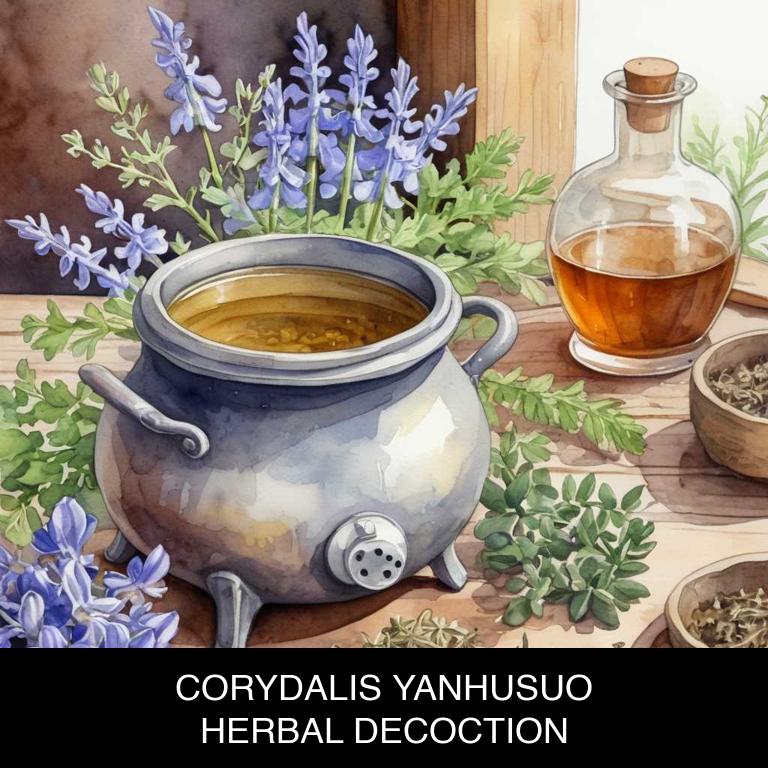
Medicinal Constituents
The list below shows the primary medicinal constituents in Corydalis yanhusuo decoctions that help with lower back pain.
- Dehydrocorybulbine: This alkaloid has been shown to have potent anti-inflammatory and analgesic properties, helping to reduce pain and inflammation associated with lower back pain.
- Corybulbine: This alkaloid has been found to have a synergistic effect with DHCB, enhancing its analgesic and anti-inflammatory properties and contributing to the overall pain-relieving effects of Corydalis yanhusuo decoctions.
- Nandinine: This alkaloid has been shown to have a direct effect on the central nervous system, inhibiting the production of pain-causing chemicals and reducing pain perception, which can help alleviate lower back pain.
Parts Used
The list below shows the primary parts of yanhusuo used to make decoctions for lower back pain.
- Roots: Corydalis yanhusuo roots are commonly used to make decoctions for lower back pain due to their analgesic and anti-inflammatory properties.
- Leaves: Corydalis yanhusuo leaves are also used to make decoctions for lower back pain due to their ability to relieve pain and reduce inflammation.
- Rhyzomes: Corydalis yanhusuo rhyzomes are used to make decoctions for lower back pain as they contain compounds that help to reduce pain and inflammation.
Quick Recipe
The following recipe gives a procedure to make a basic yanhusuo for lower back pain.
- Wash 15-30 grams of dried root of corydalis yanhusuo in cold water for 5-10 minutes to remove any impurities.
- Combine the cleaned root with 2-3 liters of water in a large pot and bring to a boil.
- Reduce the heat to a simmer and allow the decoction to steep for 30-60 minutes.
- Strain the decoction through a cheesecloth or fine-mesh sieve into a clean container to remove the solids.
- Store the finished decoction in the refrigerator and consume 50-100 ml 1-3 times a day as needed.
2. Curcuma longa
Turmeric decoctions helps with lower back pain because it contains curcumin, a potent anti-inflammatory compound that targets the root cause of discomfort.
When brewed into a decoction, turmeric's active ingredients are easily absorbed by the body, reducing inflammation and swelling in the muscles, joints, and discs of the lower back.
This natural remedy also promotes relaxation, reduces muscle spasms, and improves circulation, providing fast and effective relief from chronic pain and stiffness.
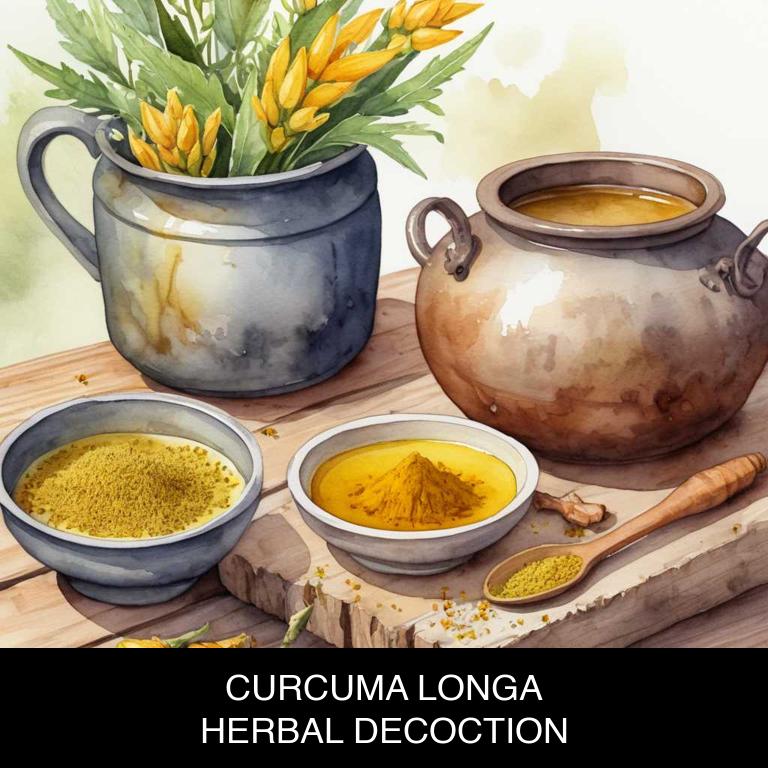
Medicinal Constituents
The list below shows the primary medicinal constituents in Curcuma longa decoctions that help with lower back pain.
- Curcumin: Curcumin, a polyphenolic compound, helps reduce lower back pain by inhibiting pro-inflammatory enzymes and cytokines that contribute to inflammation and pain in the body.
- Demethoxycurcumin: DMC, another polyphenolic compound, has potent anti-inflammatory and antioxidant properties that help alleviate lower back pain by reducing oxidative stress and inflammation in the body.
- Turmerone: Turmerone, a sesquiterpene compound, has anti-inflammatory and analgesic properties that help reduce lower back pain by inhibiting the production of pro-inflammatory enzymes and reducing pain perception.
Parts Used
The list below shows the primary parts of turmeric used to make decoctions for lower back pain.
- Roots: The roots of Curcuma longa contain a significant amount of curcumin and other compounds that contribute to their analgesic and anti-inflammatory effects.
- Barks: Although less commonly used, the barks of Curcuma longa are sometimes employed in traditional medicine to relieve lower back pain due to their reported anti-inflammatory and antioxidant properties.
Quick Recipe
The following recipe gives a procedure to make a basic turmeric for lower back pain.
- Choose 30g of dried curcuma longa roots for decoction preparation.
- Grind 10g of the chosen roots into a fine powder using a mortar.
- Combine the ground roots with 1l of water in a saucepan and boil.
- Reduce the heat to a simmer for 10-15 minutes after boiling.
- Strain the decoction through a cheesecloth into a separate container.
3. Withania somnifera
Ashwagandha decoctions helps with lower back pain because of its unique combination of anti-inflammatory, antioxidant, and analgesic properties.
The decoction's active compounds, such as withanolides and flavonoids, work synergistically to reduce muscle spasms and inflammation in the lower back, providing relief from chronic pain. Additionally, ashwagandha's adaptogenic properties help to calm stress and anxiety, which can exacerbate back pain, promoting a sense of relaxation and reducing tension that contributes to discomfort.
Regular consumption of ashwagandha decoctions may lead to long-term relief from lower back pain.
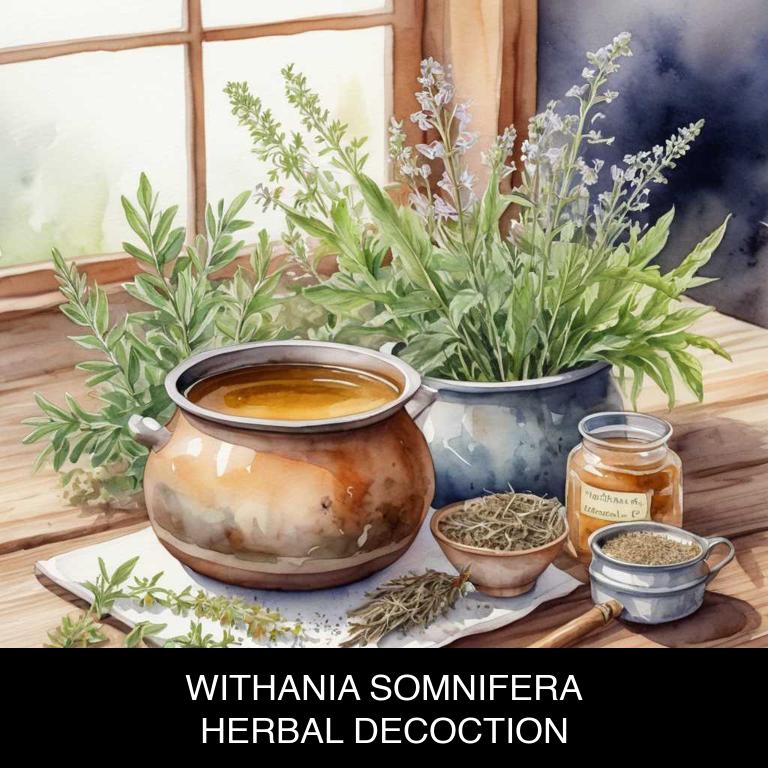
Medicinal Constituents
The list below shows the primary medicinal constituents in Withania somnifera decoctions that help with lower back pain.
- Withanolides: These triterpenoid saponins have anti-inflammatory and antioxidant properties, which help reduce inflammation and oxidative stress in the lower back, thereby alleviating pain and discomfort.
- Withaferin a: This bioactive alkaloid has potent anti-inflammatory and analgesic effects, which help block pain signals and reduce inflammation in the lower back, providing relief from pain and stiffness.
- Withanoside iv: This glycoside has anti-inflammatory and immunomodulatory properties, which help regulate the body's immune response and reduce inflammation in the lower back, thereby alleviating pain and discomfort.
Parts Used
The list below shows the primary parts of ashwagandha used to make decoctions for lower back pain.
- Roots: The roots of Withania somnifera are commonly used due to their high concentration of bioactive compounds, including withanolides, which have anti-inflammatory and analgesic properties.
- Leaves: The leaves of Withania somnifera are used due to their content of withanolides and other flavonoids, which may help alleviate muscle spasms and reduce pain associated with lower back conditions.
- Fruits: The fruits of Withania somnifera are used due to their potential to reduce inflammation and alleviate pain, possibly due to their content of various bioactive compounds, including withanolides and flavonoids.
Quick Recipe
The following recipe gives a procedure to make a basic ashwagandha for lower back pain.
- Harvest withania somnifera roots in the spring or fall when the plant is dormant to ensure the highest quality.
- Dry the harvested roots in a warm dry place for at least 2 weeks to reduce moisture content to 10%.
- Weigh 2-4 grams of dried withania somnifera roots per 150-200ml of water to create the decoction base.
- Boil the weighed roots in water for 5-10 minutes to release the active compounds into the solvent.
- Strain the decoction through a cheesecloth or fine mesh to remove the solids and discard the roots.
4. Boswellia serrata
Frankincense decoctions helps with lower back pain because of its anti-inflammatory and analgesic properties.
The Boswellia serrata resin, a key component in frankincense, has been shown to reduce inflammation and swelling in the affected area, providing relief from chronic lower back pain. Additionally, frankincense's natural chemical compounds interact with the body's endocannabinoid system, promoting relaxation and reducing muscle tension, which can contribute to lower back strain.
As a result, frankincense decoctions have been used for centuries to alleviate discomfort and promote overall spinal health.
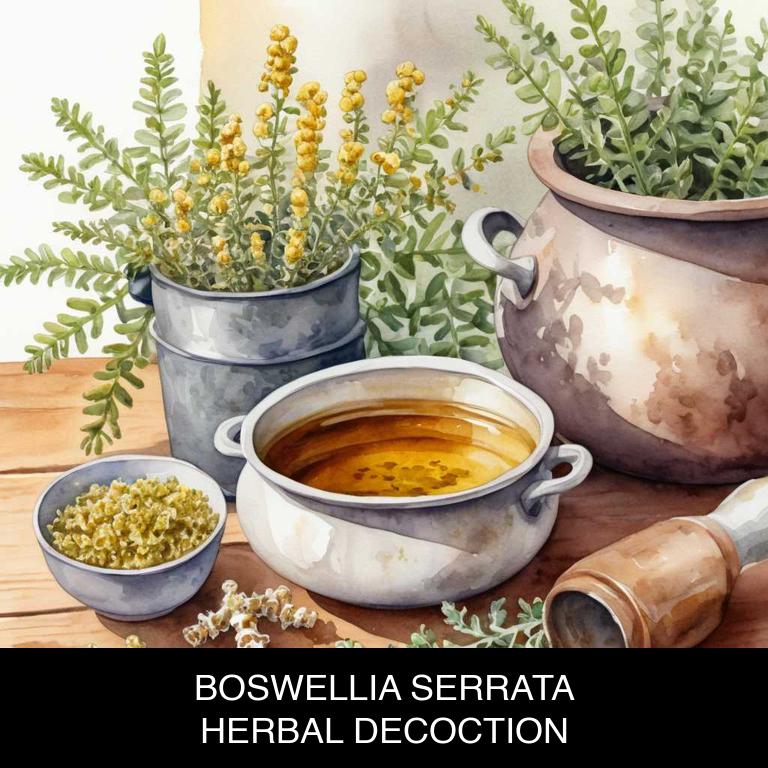
Medicinal Constituents
The list below shows the primary medicinal constituents in Boswellia serrata decoctions that help with lower back pain.
- Aleuric acid: A boswellic acid derivative that inhibits the production of pro-inflammatory eicosanoids, thus reducing inflammation and pain associated with lower back conditions.
- Acetyl-11-keto-β-boswelllic acid: A boswellic acid that inhibits the production of pro-inflammatory enzymes, such as COX-2 and 5-LOX, thereby reducing inflammation and pain in the lower back.
- 3-o-acetyl-11-keto-β-boswellic acid: A boswellic acid that has anti-inflammatory and pain-relieving properties, which may help in reducing the severity of lower back pain by inhibiting the production of pro-inflammatory mediators.
Parts Used
The list below shows the primary parts of frankincense used to make decoctions for lower back pain.
- Roots: The roots of Boswellia serrata contain high concentrations of boswellic acids, which are responsible for its anti-inflammatory and pain-relieving properties.
- Rhyzomes: The rhyzomes of Boswellia serrata, similar to its roots, contain boswellic acids and are often used to make decoctions for pain relief.
- Barks: The barks of Boswellia serrata are also a source of boswellic acids and are used to make decoctions for lower back pain and inflammation.
Quick Recipe
The following recipe gives a procedure to make a basic frankincense for lower back pain.
- Weigh 2-3 grams of dried boswellia serrata resin and grind it into a fine powder.
- Combine the ground resin powder with 1 liter of distilled water in a saucepan.
- Bring the mixture to a boil and then reduce heat to a simmer for 10-15 minutes.
- Strain the decoction through a cheesecloth or a fine-mesh sieve into a clean container.
- Store the prepared decoction in the refrigerator and consume within 3 days.
5. Zingiber officinale
Ginger decoctions helps with lower back pain because of its natural anti-inflammatory properties, which reduce muscle soreness and stiffness.
The decoction's warming effect also increases blood flow to the affected area, promoting relaxation of tense muscles and relieving tension in the lumbar region. Additionally, ginger has been shown to have analgesic effects, reducing discomfort and pain associated with lower back strain.
By soothing and calming the muscles and joints, ginger decoctions provide effective relief from chronic or acute lower back pain.

Medicinal Constituents
The list below shows the primary medicinal constituents in Zingiber officinale decoctions that help with lower back pain.
- Gingerols: These sesquiterpenoid compounds have anti-inflammatory properties, helping to reduce pain and inflammation in the lower back caused by conditions like arthritis or muscle strain.
- Shogaols: Similar to gingerols, shogaols also possess anti-inflammatory and analgesic effects, which help alleviate lower back pain by inhibiting the production of pain-causing chemicals in the body.
- 6-gingerol: As a potent anti-inflammatory and antioxidant, 6-gingerol helps reduce inflammation and oxidative stress in the lower back, promoting healing and pain relief.
Parts Used
The list below shows the primary parts of ginger used to make decoctions for lower back pain.
- Rhyzomes: They are the most commonly used part due to their high concentration of compounds like gingerol and shogaol, which have anti-inflammatory properties that help alleviate lower back pain.
- Roots: The roots of Zingiber officinale contain a compound called zingerone, which has analgesic and anti-inflammatory effects that can help relieve lower back pain.
- Stems: Although less commonly used, the stems of Zingiber officinale also contain compounds that can help reduce inflammation and alleviate lower back pain, although the exact compounds are not well-documented.
Quick Recipe
The following recipe gives a procedure to make a basic ginger for lower back pain.
- Harvest fresh zingiber officinale roots in the early morning or late evening for maximum potency.
- Wash the harvested roots under cold running water to remove dirt and debris thoroughly.
- Slice the cleaned roots into thin pieces and weigh out 3-4 grams for decoction.
- Combine the sliced roots with 250 milliliters of boiling water in a heat-resistant container.
- Simmer the mixture for 5-7 minutes then strain and discard the solids completely.
6. Salix alba
White willow decoctions helps with lower back pain because of its natural anti-inflammatory properties, which effectively reduce swelling and stiffness in the muscles and joints.
The decoction's salicin content works similarly to aspirin, targeting pain and discomfort caused by strain or injury. Additionally, white willow has a sedative effect, promoting relaxation and reducing muscle spasms that contribute to lower back pain.
As a result, regular consumption of herbal white willow decoctions can provide long-lasting relief from chronic lower back pain and improve overall well-being.
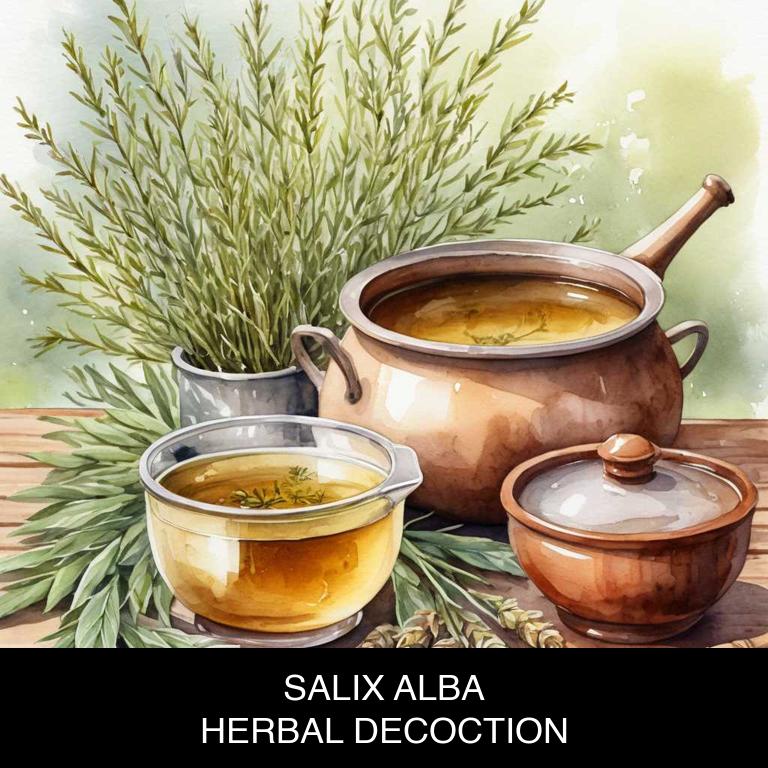
Medicinal Constituents
The list below shows the primary medicinal constituents in Salix alba decoctions that help with lower back pain.
- Salicin: Salicin, a phenolic compound, has anti-inflammatory properties that help reduce pain and inflammation associated with lower back pain.
- Quercetin: Quercetin, a flavonoid phenolic compound, has potent anti-inflammatory and antioxidant effects, which help alleviate lower back pain by reducing inflammation and promoting tissue repair.
- Tannins: Tannins, a type of polyphenol, exhibit anti-inflammatory and analgesic properties, which help relieve lower back pain by reducing pain and inflammation in the muscles and joints.
Parts Used
The list below shows the primary parts of white willow used to make decoctions for lower back pain.
- Barks: It's used due to its anti-inflammatory and analgesic properties, which help alleviate pain and reduce inflammation in the lower back.
- Leaves: They are used because of their mild analgesic and anti-inflammatory properties, which provide relief from lower back pain and discomfort.
- Stems: The stems are used due to their anti-inflammatory and warming properties, which help reduce pain and stiffness in the lower back.
Quick Recipe
The following recipe gives a procedure to make a basic white willow for lower back pain.
- Gather 40-60 grams of dried salix alba bark and rinse it with cold water.
- Weigh 1-2 grams of the dried bark and add it to 250 milliliters of boiling water.
- Steep the mixture for 15-30 minutes or until the liquid reaches a temperature of 95-100 degrees fahrenheit.
- Strain the liquid through a cheesecloth or fine-mesh sieve into a clean container to remove the solids.
- Discard the solids and store the decoction in the refrigerator for up to 3 days.
7. Valeriana officinalis
Valerian decoctions helps with lower back pain because it has natural analgesic and anti-inflammatory properties that help to soothe and calm the muscles and joints.
The decotion's sedative effects also promote relaxation, which can help to reduce muscle tension and alleviate pressure on the spine.
Additionally, valerian root is a natural muscle relaxant, which can help to reduce spasms and stiffness in the lower back, providing long-lasting relief from pain and discomfort.
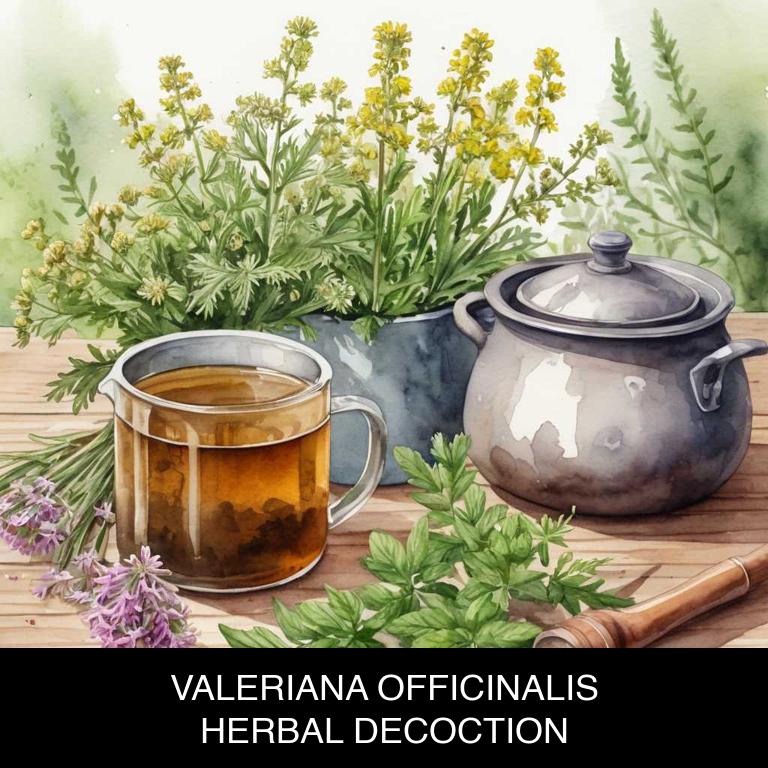
Medicinal Constituents
The list below shows the primary medicinal constituents in Valeriana officinalis decoctions that help with lower back pain.
- Valerenic acid: This sesquiterpene acid has analgesic and anti-inflammatory properties, which help reduce pain and inflammation associated with lower back pain.
- Valerenol: This valerenol is a sesquiterpenoid alcohol that has a sedative effect, which can help relax muscles and reduce muscle spasms in the lower back, thereby relieving pain.
- Isovaleric acid amide: This amide has analgesic and anti-inflammatory properties, which can help reduce pain and inflammation in the lower back, while also promoting relaxation and reducing muscle spasms.
Parts Used
The list below shows the primary parts of valerian used to make decoctions for lower back pain.
- Roots: The roots are the primary part used due to their high concentration of valerenic acid, which has analgesic and anti-inflammatory properties.
- Leaves: The leaves may also be used, although to a lesser extent, as they contain lesser amounts of valerenic acid, but still offer some relief from pain and inflammation.
Quick Recipe
The following recipe gives a procedure to make a basic valerian for lower back pain.
- Harvest 3-4 ounces of dried valeriana officinalis roots in the spring or fall season.
- Rinse the dried roots with cold water to remove any debris or dust.
- Combine 1 cup of water with 1-2 teaspoons of dried valeriana officinalis roots in a saucepan.
- Bring the mixture to a boil then reduce heat and simmer for 5-10 minutes.
- Strain the decoction and discard the solids to obtain the herbal remedy.
8. Harpagophytum procumbens
Devil's claw decoctions helps with lower back pain because of its unique combination of natural compounds that have potent anti-inflammatory and analgesic properties.
The decoction, made from the root of the devil's claw plant, has been traditionally used to ease muscle and joint pain, including lower back pain caused by conditions such as arthritis, sciatica, and herniated discs.
It helps to reduce inflammation, relax muscles, and improve mobility, providing fast and effective relief from discomfort and stiffness.
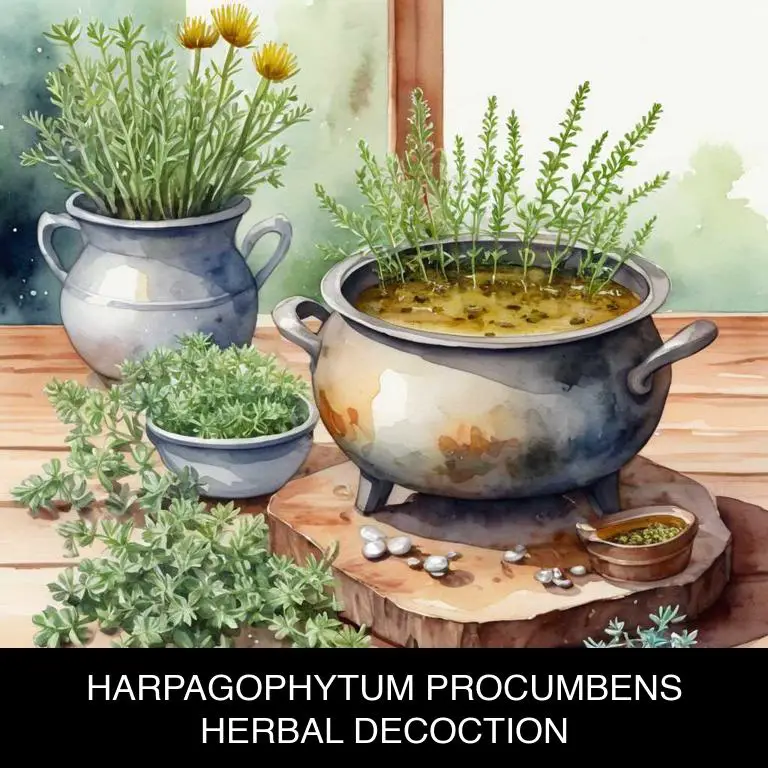
Medicinal Constituents
The list below shows the primary medicinal constituents in Harpagophytum procumbens decoctions that help with lower back pain.
- Harpagide: This iridoid glycoside has anti-inflammatory and analgesic properties, helping to reduce pain and inflammation associated with lower back pain.
- Betalains: Harpagophytum procumbens contains betalains, a class of water-soluble pigments with antioxidant and anti-inflammatory properties, which may help alleviate lower back pain by reducing oxidative stress and inflammation.
- Harpagoside: This iridoid glycoside has been shown to exhibit anti-inflammatory, analgesic, and anti-arthritic properties, contributing to its potential pain-relieving effects on lower back pain.
Parts Used
The list below shows the primary parts of devil's claw used to make decoctions for lower back pain.
- Roots: The roots contain high concentrations of harpagoside, a key compound that provides anti-inflammatory and pain-relieving properties.
- Barks: The barks are used to extract harpagoside and other compounds that help reduce inflammation and alleviate pain in the lower back.
- Stems: The stems contain similar compounds to the roots, making them a viable alternative for decoctions that help manage lower back pain.
Quick Recipe
The following recipe gives a procedure to make a basic devil's claw for lower back pain.
- Gather 30-60 grams of dried root of harpagophytum procumbens for decoction preparation.
- Combine the root with 1 liter of water in a saucepan and bring to a boil.
- Reduce heat to simmer for 5-10 minutes to allow for extraction of active compounds.
- Strain the decoction through a cheesecloth or fine-mesh sieve into a container.
- Allow the decoction to cool before storing it in the refrigerator for up to 3 days.
9. Capsicum annuum
Bell pepper decoctions helps with lower back pain because they contain a unique combination of bioactive compounds that work synergistically to reduce inflammation, relax muscles, and improve circulation.
The antioxidants and flavonoids present in bell peppers help to neutralize free radicals, which can contribute to muscle tension and pain.
Additionally, the anti-inflammatory properties of bell pepper decoctions may help to reduce swelling and discomfort in the lower back, providing relief from chronic pain and stiffness.
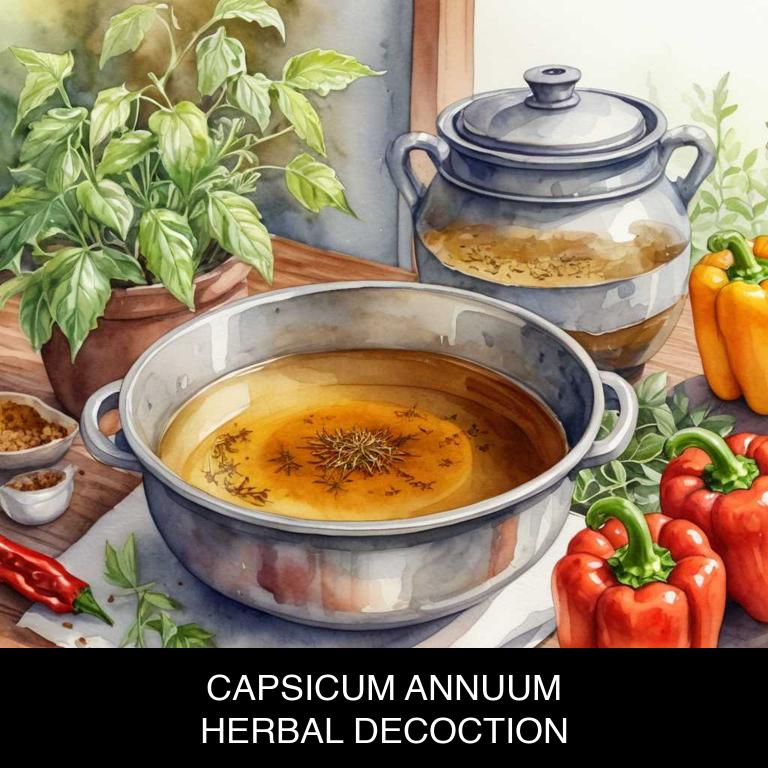
Medicinal Constituents
The list below shows the primary medicinal constituents in Capsicum annuum decoctions that help with lower back pain.
- Capsaicin: Capsaicin helps with lower back pain by inhibiting the production of a chemical called substance P, which transmits pain signals to the brain, thereby reducing pain perception.
- Capsaicinoid-related phenolic compounds: Capsaicinoid-related phenolic compounds, such as ferulic acid and vanillic acid, have anti-inflammatory and antioxidant properties that help reduce inflammation and oxidative stress in the lower back, thereby alleviating pain.
- Diosphenol: Diosphenol, a phenolic compound in Capsicum annuum, has analgesic and anti-inflammatory properties that help reduce pain and inflammation in the lower back, promoting relaxation and reducing discomfort.
Parts Used
The list below shows the primary parts of bell pepper used to make decoctions for lower back pain.
- Fruits: They are used due to their high capsaicin content, which helps to reduce pain and inflammation in the lower back.
- Leaves: They are used to create a soothing and anti-inflammatory decoction, which helps to relax the muscles and reduce pain in the lower back.
- Seeds: They are used to create a warm and invigorating decoction, which helps to stimulate blood flow and reduce pain and stiffness in the lower back.
Quick Recipe
The following recipe gives a procedure to make a basic bell pepper for lower back pain.
- Harvest 10-15 fresh capsicum annuum fruits when they are fully ripe and have a deep red color.
- Clean the harvested capsicum annuum fruits thoroughly to remove any dirt or debris.
- Chop the cleaned capsicum annuum fruits into small pieces weighing about 5 grams each.
- Boil 500 ml of water and add the chopped capsicum annuum pieces to it for 10 minutes.
- Strain the decoction using a cheesecloth or a fine mesh and discard the solids.
10. Carthamus tinctorius
Safflower decoctions helps with lower back pain because of its anti-inflammatory properties, which reduce swelling and ease tension in the muscles.
The decoction's analgesic effects also provide relief from pain, allowing individuals to move more comfortably. Additionally, safflower's ability to relax the muscles and improve blood circulation helps to reduce stiffness and strain, promoting healing and recovery.
By addressing the underlying causes of lower back pain, safflower decoctions offer a natural and effective solution for managing discomfort and improving overall well-being.
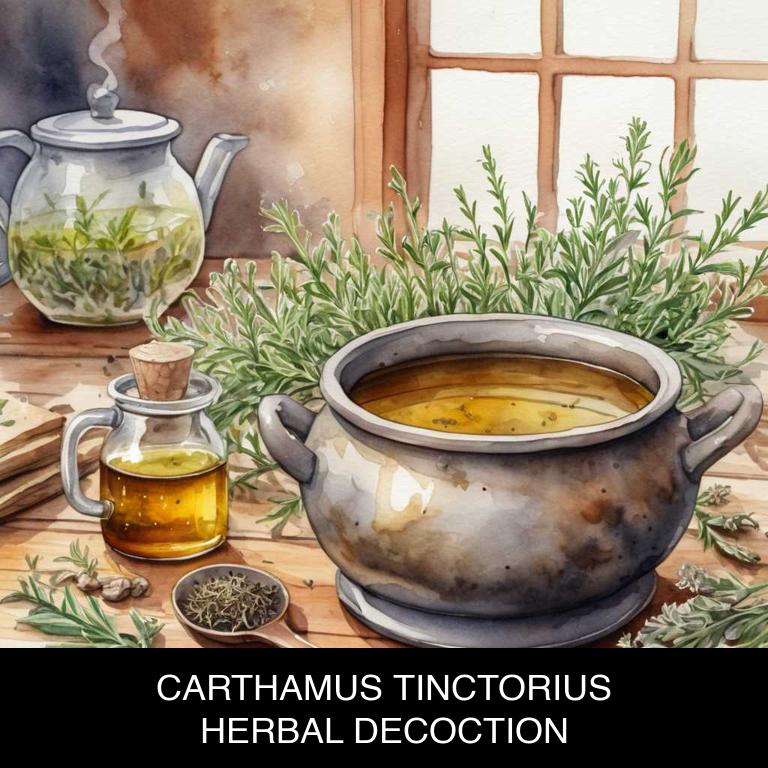
Medicinal Constituents
The list below shows the primary medicinal constituents in Carthamus tinctorius decoctions that help with lower back pain.
- Lupulones: These sesquiterpenoid lactones have anti-inflammatory and analgesic properties, which help reduce inflammation and pain associated with lower back conditions.
- Phenolic acids: These compounds exhibit potent antioxidant and anti-inflammatory activities, which may help alleviate oxidative stress and inflammation contributing to lower back pain.
- Flavonoids: As flavonoids possess anti-inflammatory, antioxidant, and analgesic properties, they may help mitigate lower back pain by reducing inflammation and promoting tissue repair.
Parts Used
The list below shows the primary parts of safflower used to make decoctions for lower back pain.
- Seeds: Used for their anti-inflammatory properties to reduce pain and inflammation in the lower back.
- Roots: Utilized for their analgesic and anti-inflammatory effects to alleviate lower back pain and stiffness.
- Leaves: Employed for their antioxidant and anti-inflammatory properties to reduce inflammation and promote relaxation in the lower back area.
Quick Recipe
The following recipe gives a procedure to make a basic safflower for lower back pain.
- Harvest 100g of dried carthamus tinctorius flowers or use 200g of fresh flowers.
- Rinse the dried flowers with cold water or chop the fresh flowers into smaller pieces.
- Steep 10g of dried flowers or 20g of fresh flowers in 250ml of boiling water for 5-10 minutes.
- Strain the mixture through a cheesecloth or a fine-mesh sieve into a clean container.
- Store the decoction in the refrigerator and consume within 24 hours.
What is the best combination of herbal decoctions to use for lower back pain?
The best combination of herbal decoctions that help with lower back pain is a blend of Willow bark, Turmeric, and Ginger.
Willow bark contains salicin, which has anti-inflammatory properties that reduce pain and inflammation. Turmeric contains Curcumin, a powerful antioxidant that reduces inflammation and promotes healing. Ginger, with its warming and anti-inflammatory properties, helps to relax the muscles and improve circulation, thereby alleviating lower back pain.
This combination can be consumed as a tea or added to warm water for a soothing and effective remedy.
What ailments similar to lower back pain are treated with herbal decoctions?
Ailments similar to lower back pain that are treated with herbal decoctions are sciatica, arthritis, and fibromyalgia.
These conditions often manifest as chronic pain, stiffness, and inflammation in the muscles and joints.
Herbal decoctions made from herbs like Turmeric, Ginger, Willow Bark, and Stinging Nettle have anti-inflammatory and analgesic properties that help alleviate these symptoms, providing relief from pain and discomfort.